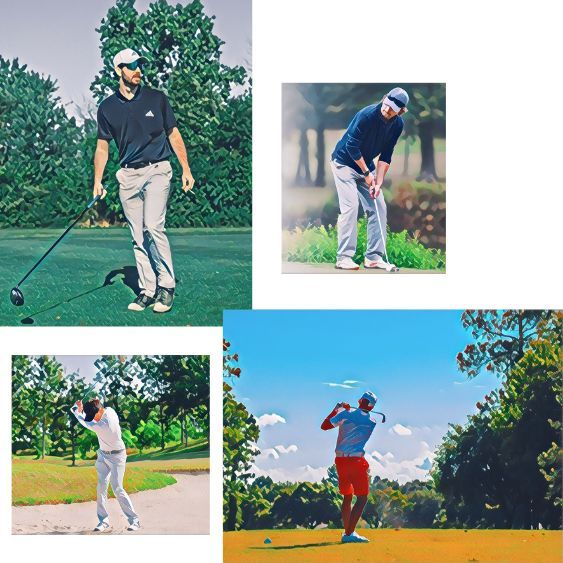Have you ever wondered how those pro golfers make it look so easy?
Well, they've had years of practice and some natural talent, but that's not the whole story.
The truth is, anyone can learn how to swing a golf club like a pro — it just takes a little bit of patience and some proper instruction.
Take it from this golf legend.

Ben Hogan’s Five Lessons: The Modern Fundamentals of Golf
- Kindle, read with a free app, on any device
- Instructional book on the fundamentals of the game of golf by a golf legend renowned for his swing, Ben Hogan.
In the paragraphs below, we'll walk you through everything you need to know about swinging a golf club — from grip to follow-through.
Whether you're just getting started or looking to improve your game, read on for our beginner's guide to swinging a golf club.
The Grip
One of the most important aspects of swinging a golf club is getting your grip right. There are three main ways to grip the club: overlapping, interlocking, and 10-finger.
Overlapping
Overlapping is the most common grip among professional golfers, as it gives you the most control over the club.
To overlap grip the club:
- place your pinkie finger on top of the space between your index and middle fingers on your left hand (if you're right-handed).
- Then take your right hand and put it overtop of your left, wrapping your pinkie finger around the pinkie on your left hand.
- Finally, adjust both hands until they're comfortable and the V created by your thumb and forefinger on each hand points toward your right shoulder.
Interlocking Grip
The interlocking grip is similar to the overlapping grip, except that — instead of placing your pinkie finger on top of the space between your index and middle fingers — you actually tuck it underneath those fingers.
This can give you a bit more control over the club but may feel less comfortable for some people.
*If you want to try an interlocking grip, follow the same steps outlined above but tuck your pinkie finger underneath instead of over top.
Experiment with both grips to see which feels best for you.
10-Finger Grip (also known as baseball grip)
The 10-finger grip is exactly what it sounds like—all 10 fingers are wrapped around the club.
This is usually only done by beginner golfers as it gives you very little control over the club. If you are new to golfing, start with one of the other two grips before moving on to this one.
The Stance
Once you've got a good grip on things (pun intended), it's time to set up your shot. First things first: take a deep breath and relax—golf should be fun!
Your stance is an important factor in delivering accurate shots.
Now, check your stance by placing your feet shoulder-width apart with weight balanced evenly between both feet and legs slightly bent at the knees.
As for where to place their feet relative to the ball, beginners should aim for placing their left foot (again, for right-handed golfers) just behind the ball at the address.
From there, take a small step back with your right foot until both feet are shoulder-width apart and you feel balanced.
With stance out of the way, it's finally time to start swinging.
The Swing
There are two main parts to any golf swing: the backswing and the follow-through.
- Starting with the backswing, take hold of the club with both hands and raise it up behind you so that it's pointing upwards at roughly a 45-degree angle relative to the ground.
- When you've reached that point—your arms should be fully extended—begin slowly winding your body back while keeping your arms raised.
- Once you've coiled as far back as possible—again keeping those arms raised—start uncoiling your body as you simultaneously bring the club down and around in front of you.
*At this point in the swing, you'll want to make sure that you're still holding on tightly with both hands; many amateur golfers tend to loosen their grip as they start their downswing only to have their shot go wild as a result.
- Finally, once the club has reached waist level in front of you (your arms should still be extended), start following through by turning your hips and shoulders towards the target as you release all that pent-up power from your coiled backswing into an explosive follow-through finish.*
*Remember to keep Your Eyes fixed On The Ball throughout The Entire Swing!
And there you have it!
With these basics under your belt, you're well on your way to becoming a bonafide golfer.
Just remember: practice makes perfect! — The more time you spend perfecting your swing on the driving range or putting green, the better player you'll become out on the course.
Or, you could try this trainer at home!

Real Swing 300 Golf Swing & Hitting Trainer
- True Impact, Checking Path After Swing Practice Mat Groover Training Aid, Height Adjustable
The Takeaway
"From grip to follow through" — now you have the basics!
The next steps? ... Execution and practice - practice - practice ...
And if you're in the market for some golf clubs, this short guide on golf clubs might help ... just as much as this article on waterproof golf shoes may come in handy.
Hoping this helps all fellow beginning golfers out there get their swings in order!
And again … keep calm & Enjoy The Game :).
Happy swinging and Go Hit Em Straight!
Disclaimer.
When you purchase through links on our site, we may earn an affiliate commission. We sometimes use affiliate links to products and services on retailer sites for which we can receive compensation if you click on those links or make purchases through them.








